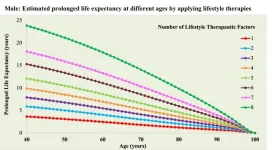(Press-News.org) A group of Chinese scientists has recently found key evidence for the existence of nanohertz gravitational waves, marking a new era in nanohertz gravitational wave research. The research was based on pulsar timing observations carried out with the Five-hundred-meter Aperture Spherical Telescope (FAST).
The research was conducted by the Chinese Pulsar Timing Array (CPTA) collaboration. Researchers (Prof. Kejia Lee, Post-Doc. Siyuan Chen, PhD students Jiangwei Xu, and Zihan Xue) from Department of Astronomy School of Physics and Kavli Institute of Astronomy and Astrophysics of Peking University played vital roles in the collaboration. Their findings were published online in the academic journal Research in Astronomy and Astrophysics (RAA).
Accelerations of massive objects disturb the surrounding space-time and produce the "ripples", or gravitational waves. The detection of nanohertz gravitational waves will help astronomers understand the formation of universe structures, and investigate the growth, evolution, and merger of supermassive black holes, the most massive celestial objects in the Universe. It will also help physicists gain insights into the fundamental physical laws of space-time. The CPTA collaboration used FAST to conduct long-term systematic monitoring of 57 millisecond pulsars. These millisecond pulsars form a Galactic-scale gravitational wave detector sensitive to the nanohertz gravitational waves. Based on data collected via FAST that spanned 3 years and 5 months, the CPTA team found evidence for the quadrupole correlation signatures compatible with the prediction of nanohertz gravitational waves at a 4.6 sigma statistical confidence level (false alarm probability of two of a million).
The gravitational wave signals are extremely weak, but they directly probe the masses that do not emit light in the universe. Opening up the cosmic observation window for gravitational waves has been one of the key goals that astronomers have been pursuing for a long time. Between the 1970s and 1980s, the existence of gravitational waves was indirectly confirmed by observing the orbital changes of pulsar binary systems, which led to the 1993 Nobel Prize in Physics for Hulse and Taylor. In 2016, the Laser Interferometer Gravitational-Wave Observatory (LIGO) announced the detection of gravitational waves from the merger of stellar-mass binary black holes in the 100-Hz frequency band, and soon won the 2017 Nobel Prize in Physics. More massive objects produce gravitational waves with lower frequencies. For example, the most massive celestial body in the universe, the supermassive black hole binaries (100 million to 100 billion times the solar mass) in the center of the galaxies mainly generate gravitational waves in the nanohertz band, and the corresponding signal time scale is from years to decades. In this frequency band, there are also gravitational wave contributions from early universe processes and exotic objects such as cosmic strings. Similar to LIGO, PTA is a direct GW detection method, where LIGO measures the phase of laser to detect GW and PTA measures the phase of pulsar rotation.
Taking advantage of FAST’s high sensitivity, the CPTA research team has monitored 57 millisecond pulsars with regular cadence for 41 months. The team found key evidence for quadrupole correlation signatures compatible with the prediction of nanohertz gravitational waves at a 4.6-sigma statistical confidence level (with a false alarm probability of two in a million).
The team used independently developed data analysis software and data processing algorithms to achieve its breakthrough on the same time as other international groups. Independent data processing pipelines produced compatible results.
The time span of CPTA data set is much shorter than the time spent by other telescopes to detect gravitational waves. However, due to the high sensitivity of FAST telescope, in just 3.5 years the CPTA achieved similar sensitivity compared to other PTAs. Future observations will soon extend the span of CPTA data and help in identifying the astrophysical sources or sources of current signal.
Objects of greater mass produce gravitational waves of lower frequency. For example, the most massive celestial body in the universe, the supermassive black hole binaries (with 100 million to 100 billion times the solar mass) in the center of galaxies, mainly generate gravitational waves in the nanohertz band, with corresponding signal time scales from years to decades. This frequency band also includes gravitational wave contributions from processes of the early Universe as well as exotic objects such as cosmic strings.
Using nanohertz gravitational waves in cosmic observation is thus hugely important in studying key problems in contemporary astrophysics such as supermassive black holes, the history of galaxy mergers, and the formation of large-scale structures in the Universe.
The detection of nanohertz gravitational waves is very challenging, though, due to their extremely low frequency, where the corresponding period can be as long as several years and wavelengths up to several light-years. So far, long-term timing observation of millisecond pulsars with extreme rotational stability is the only known method for effectively detecting nanohertz gravitational waves.
Hunting for these waves is one of the major focuses of present-day physics and astronomy. Regional pulsar timing array collaborations, including the North American Nanohertz Observatory for Gravitational Waves (NANOGrav), the European Pulsar Timing Array (EPTA), and the Australian Parkes Pulsar Timing Array (PPTA), have been collecting pulsar timing data for more than 20 years, with the aim of detecting nanohertz gravitational waves. Recently, several new regional collaborations have also joined this field, including CPTA, the India Pulsar Timing Array (InPTA), and the South Africa Pulsar Timing Array (SAPTA). NANOGrav, EPTA, and PPTA will announce similar results compatible to the current CPTA findings at the same day.The detection sensitivity of pulsar timing arrays to nanohertz gravitational waves strongly depends on the observational time span—that is, sensitivity grows rapidly with the increase in observational time span.
In the future, these regional collaborations will promote international pulsar timing array collaboration and expand exploration of the Universe through nanohertz gravitational wave observations.
Paper: https://iopscience.iop.org/article/10.1088/1674-4527/acdfa5
Source: KIAA
END
PKUers finds key evidence for existence of nanohertz gravitational waves
2023-07-24
ELSE PRESS RELEASES FROM THIS DATE:
MSU study links cadmium levels in women’s urine to endometriosis
2023-07-24
EAST LANSING, Mich. – Women with a history of endometriosis had higher concentrations of cadmium in their urine compared to those without that diagnosis, according to a Michigan State University study that suggests the toxic metal could be linked to the development of endometriosis.
Affecting one in 10 reproductive-age women, endometriosis is a gynecologic condition in which tissue that looks like the lining of the uterus, or womb, appears outside the uterus. Those with endometriosis can experience chronic, painful and debilitating symptoms, which can interfere with all aspects of life, including daily activity, work productivity, ...
Breastfeeding is associated with a 33% reduction in first-year post-perinatal infant mortality
2023-07-24
Ann Arbor, July 24, 2023 - Among nearly 10 million US infants born between 2016 and 2018, breastfed babies were 33% less likely to die during the post-perinatal period (day 7−364) than infants who were not breastfed, reports a new study in the American Journal of Preventive Medicine, published by Elsevier. The findings build on previous US research with smaller datasets, which documented the association between the initiation of breastfeeding and the reduction of post-perinatal infant mortality by a range of 19% to 26%.
Lead investigator Julie L. Ware, MD, MPH, ...
Large study determines number needed to be vaccinated to prevent COVID-19 hospitalizations and ED visits
2023-07-24
An analysis of real-world data from more than 1.2 million patients from health systems in four geographically dispersed states -- Indiana, Oregon, Texas and Utah -- conducted by the U.S. Centers for Disease Control and Prevention’s VISION Network, has determined both the number of adults needed to be vaccinated to prevent one COVID-19 associated hospitalization and the number needed to be vaccinated to prevent one COVID-19 associated emergency department (ED) visit.
This study is one of the first, ...
These eight habits could lengthen your life by decades
2023-07-24
A new study involving over 700,000 U.S. veterans reports that people who adopt eight healthy lifestyle habits by middle age can expect to live substantially longer than those with few or none of these habits. The eight habits are: being physically active, being free from opioid addiction, not smoking, managing stress, having a good diet, not regularly binge drinking, having good sleep hygiene, and having positive social relationships.
According to the results, men who have all eight habits at age 40 would be predicted to live an average of 24 years longer than men with none of these habits. For women, having all eight healthy lifestyle factors ...
Nutritional content of most milk alternatives doesn’t measure up to cow’s milk
2023-07-24
More people are drinking milk alternatives made from plant sources such as oats, soy, or almonds, but do plant-based products deliver the same nutrition as cow’s milk? Results from a new study suggest that most don’t.
Cow’s milk is an important source of calcium and vitamin D, both of which are identified in the 2020-2025 Dietary Guidelines for Americans as nutrients of public health concern for underconsumption. Cow’s milk is also a major source of protein in the American diet.
To assess how the nutritional content of plant-based milk alternatives compares to that of cow’s milk, researchers examined more than ...
How people judge anti-vaxxers who die from COVID-19
2023-07-24
COLUMBUS, Ohio – When people who publicly reject COVID-19 vaccines later die from the disease, observers have complex reactions to their fates, a new study suggests.
While very few rejoice in the deaths of anti-vaxxers, some people believe those who are dogmatic against vaccines are deserving of worse outcomes – and that reaction is related to the political party affiliation and vaccination status of the person evaluating the anti-vaxxer.
Democrats and those who were vaccinated were more likely than Republicans and the unvaccinated to think anti-vaxxers who died got what they deserved ...
Robot preachers get less respect, fewer donations
2023-07-24
As artificial intelligence expands across more professions, robot preachers and AI programs offer new means of sharing religious beliefs, but they may undermine credibility and reduce donations for religious groups that rely on them, according to research published by the American Psychological Association.
“It seems like robots take over more occupations every year, but I wouldn’t be so sure that religious leaders will ever be fully automated because religious leaders need credibility, and robots aren’t credible,” said lead researcher Joshua Conrad Jackson, PhD, an assistant professor at the University of ...
Plastic surgery goes to the movies: Journal of Craniofacial Surgery looks at facial disfigurement
2023-07-24
July 24, 2023 – Characters with facial disfigurement have long been a recurring theme in films. Their characteristics and outcomes lend insights into perceptions of facial deformities and the effects of plastic surgery, reports a study in The Journal of Craniofacial Surgery under the guidance of Editor-in-Chief Mutaz B. Habal, MD, FRCS, FACS of Tampa, Florida. The journal is published in the Lippincott portfolio by Wolters Kluwer.
Movie characters who undergo successful plastic surgery to improve their facial appearance are more likely to have happy endings, according to the new research by Young Suk Kim, BA, and Kun Hwang, MD, PhD, of Armed Forces ...
Opting for olive oil could boost brain health
2023-07-24
A new study suggests that incorporating olive oil into your diet could help reduce the risk of dying from dementia. As many countries face rising rates of Alzheimer’s disease and other forms of dementia, the study offers hope that healthy lifestyle factors such as diet can help to prevent or slow the progression of these devastating conditions.
“Our study reinforces dietary guidelines recommending vegetable oils such as olive oil and suggests that these recommendations not only support heart health but potentially brain health, as well,” said Anne-Julie Tessier, RD, PhD, a postdoctoral fellow at the Harvard T.H. ...
Upping your intake of omega-3s may help protect your hearing
2023-07-24
Researchers report that blood levels of the omega-3 fatty acid docosahexaenoic acid (DHA) were inversely correlated with hearing difficulty in a new population-based cross-sectional study. Middle-aged and older adults with higher DHA levels were 8-20% less likely to report age-related hearing issues than those with lower DHA levels.
“Higher DHA levels have previously been found to be associated with a lower risk of heart disease, cognitive impairment, and death. Our study extends these findings to suggest a role for DHA in maintaining ...


